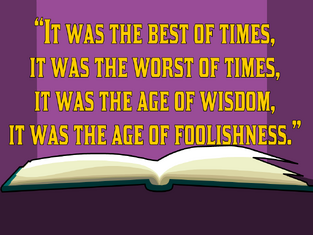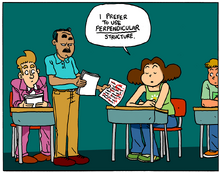| Parallel Structure | |||
|---|---|---|---|
 | |||
| Airdate | March 30, 2012 | ||
| Curriculum | English | ||
Parallel Structure is a BrainPOP English video launched on March 30, 2012.
Summary[]
Moby is so sad because the Empty Vee Network has cancelled his favorite show; "Dancing With America's Next Top Housewife". Tim tells Moby to write a letter to put the show back on the air.
Transcript[]
Quiz[]
Reference[]
Appearances[]
FYIs[]
Language[]

Parallel structure is a rhetorical device—a sort of trick that makes writing stronger and more persuasive. Several other rhetorical devices depend on parallel structure to work, and here’s a look at some of them.
Antithesis involves comparing two opposite ideas. In his “I Have a Dream” speech, Martin Luther King, Jr. envisioned a world in which his children “will not be judged by the color of their skin, but by the content of their character.”
Anaphora is the repetition of a phrase at the beginning of several clauses. Anaphora occurs at the start of Charles Dickens’s A Tale of Two Cities: “It was the best of times, it was the worst of times, it was the age of wisdom, it was the age of foolishness.”
Anticlimax usually is used for humorous effect. There’s a group of phrases with intensifying emotion—but the last phrase in the sequence undercuts the whole thing. American humorist Dorothy Parker was a master of this device. One of her poems reads: “Oh, life is a glorious cycle of song/A medley of extemporanea/And love is a thing that can never go wrong/And I am Marie of Romania.”
Epistrophe is the repetition of a phrase at the end of several clauses. Abraham Lincoln (pictured) used epistrophe at the end of his Gettysburg Address: “Government of the people, by the people, for the people shall not perish from the earth.”
Asyndeton occurs when a writer or speaker lists items without using conjunctions like and or or. During World War II, British Prime Minister Winston Churchill used asyndeton to describe how his countrymen would resist a Nazi invasion: “We shall fight in the fields and in the streets, we shall fight in the hills; we shall never surrender."
Quotables[]

We real cool. We
Left school. We
Lurk late. We
Strike straight. We
Sing sin. We
Thin gin. We
Jazz June. We
Die soon.
–Gwendolyn Brooks (pictured), American poet
“Your manuscript is both good and original, but the part that is good is not original, and the part that is original is not good.” –Samuel Johnson, English writer, criticizing an aspiring writer
“We cannot dedicate, we cannot consecrate, we cannot hallow this ground. The brave men, living and dead, who struggled here, have consecrated it, far above our poor power to add or detract. The world will little note, nor long remember what we say here, but it can never forget what they did here.” –Abraham Lincoln, 16th U.S. President, in his Gettysburg Address of 1863
“What a piece of work is a man! how noble in reason!
how infinite in faculty! in form and moving how
express and admirable! in action how like an angel!
in apprehension how like a god!”
–William Shakespeare, English author
“Let every nation know, whether it wishes us well or ill, that we shall pay any price, bear any burden, meet any hardship, support any friend, oppose any foe, to assure the survival and the success of liberty.” –John F. Kennedy, 35th U.S. President, in his 1961 Inaugural Address
Arts And Entertainment[]

Parallel structure can be found everywhere from political speeches to poetry. Needless to say, it can be found in popular songs as well!
Back in 1965, a rock band called the Byrds hit number 1 on the pop chart with a song called “Turn! Turn! Turn!” Written by folksinger Pete Seeger, the song’s lyrics are entirely in parallel structure, and were taken, word-for-word, from a passage in the Old Testament, or Hebrew Bible. The passage lists experiences—both happy and sad—that humans undergo, and notes that there is “a time” for all of them: “A time to kill, and a time to heal; a time to break down, and a time to build up; a time to weep, and a time to laugh; a time to mourn, and a time to dance.”
Canadian singer-songwriter Alanis Morissette notched a Top 20 hit in 1998 with “Thank U,” which uses parallelism to describe both a literal journey to India and an emotional journey of self-discovery. “The moment I let go of it was/The moment I got more than I could handle/The moment I jumped off of it was/ The moment I touched down,” she sings.
One of the biggest hits of 2010 was “Tik Tok” by Ke$ha, which held the number 1 position on the Billboard chart from January through March. The lyrics go, in part: “Trying on all our clothes/Boys blowing up our phones/Playing our favorite CDs/Pulling up to the parties.”
Politics[]

January 20, 1961 was a bitterly cold day in Washington, DC. A thick layer of snow blanketed the ground. Nevertheless, a huge crowd gathered on the National Mall to witness the inauguration of the nation’s 35th U.S. President, John F. Kennedy.
The charming, handsome Kennedy was the youngest President ever elected, and, to many people, his swearing-in represented the dawn of a promising new era. The brief speech he gave that morning reinforced that idea. As Massachusetts Senator John Kerry recalled 50 years later, “It took President Kennedy just 1,355 words to summon a new generation and set in motion generations of service and sacrifice—to reignite the fires of idealism and patriotism in millions of Americans.”
Kennedy repeatedly used parallel structure to emphasize his ideas. Most famously, he told Americans to “ask not what your country can do for you—ask what you can do for your country,” a phrase he borrowed from the Ancient Roman statesman Cicero.
But there were many others examples of parallelism as well. “We observe today not a victory of party, but a celebration of freedom; symbolizing an end, as well as a beginning; signifying renewal, as well as change,” he said, later adding that “the torch has been passed to a new generation of Americans—born in this century, tempered by war, disciplined by a hard and bitter peace, proud of our ancient heritage.”
Equally stirring was his promise to “pay any price, bear any burden, meet any hardship, support any friend, oppose any foe, to assure the survival and the success of liberty.”
Sadly, Kennedy’s Presidency was short, as he was murdered by an assassin in November 1963. But his inaugural address will be remembered as one of the great American political speeches of all time.
FYI Comic[]

